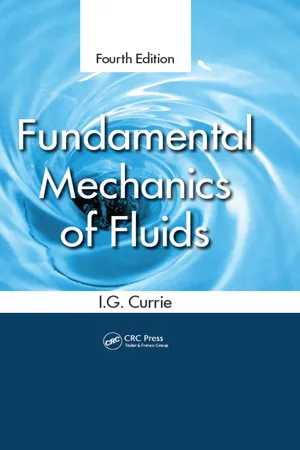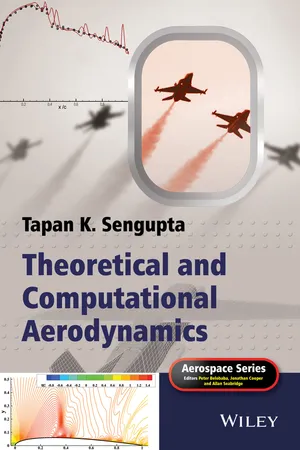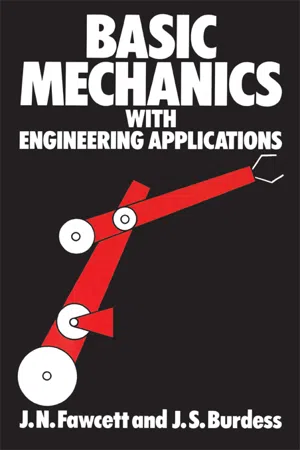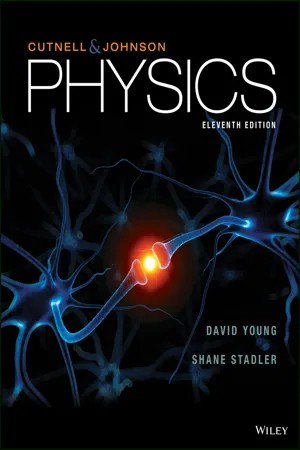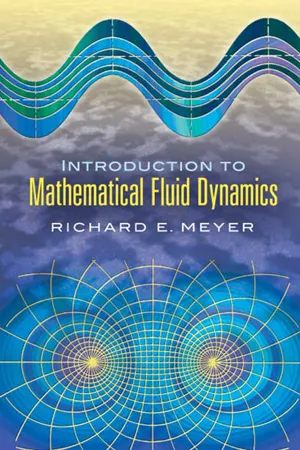Technology & Engineering
Linear Momentum Equation
The linear momentum equation, also known as Newton's second law of motion, states that the rate of change of momentum of an object is directly proportional to the force acting on it. Mathematically, it is expressed as F = dp/dt, where F is the force, p is the momentum, and t is time. This equation is fundamental in understanding and analyzing the motion of objects.
Written by Perlego with AI-assistance
Related key terms
Related key terms
1 of 4
Related key terms
1 of 3
7 Key excerpts on "Linear Momentum Equation"
- eBook - ePub
- I.G. Currie(Author)
- 2016(Publication Date)
- CRC Press(Publisher)
j . With this simplification, the equation that expresses conservation of momentum becomesIt is useful to recall that this equation came from an application of Newton’s second law to an element of the fluid. The left side of Equation 1.4 represents the rate of change of momentum of a unit volume of the fluid (or the inertia force per unit volume). The first term is the familiar temporal acceleration term, while the second term is a convective acceleration and accounts for local accelerations (such as when flowing around obstacles) even when the flow is steady. Note also that this second term is nonlinear since the velocity appears quadratically. On the right-hand side of Equation 1.4 are the forces causing the acceleration. The first of these is due to the gradient of surface shear stresses, while the second is due to body forces, such as gravity, which act on the mass of the fluid. A clear understanding of the physical significance of each of the terms in Equation 1.4 is essential when approximations to the full governing equations must be made. The surface-stress tensor σij has not been fully explained up to this point, but it will be investigated in detail in a later section.1.8 Conservation of EnergyThe principle of conservation of energy amounts to an application of the first law of thermodynamics to a fluid element as it flows. The first law of thermodynamics applies to a thermodynamic system that is originally at rest and, after some event, is finally at rest again. Under these conditions, it is stated that the change in internal energy, due to the event, is equal to the sum of the total work done on the system during the course of the event and any heat that was added. Although a specified mass of fluid in a Lagrangian frame of reference may be considered a thermodynamic system, it is, in general, never at rest and therefore never in equilibrium. However, in the thermodynamic sense, a flowing fluid is seldom far from a state of equilibrium, and the apparent difficulty may be overcome by considering the instantaneous energy of the fluid to consist of two parts: intrinsic or internal energy and kinetic energy. That is, when applying the first law of thermodynamics, the energy referred to is considered to be the sum of the internal energy per unit mass e and the kinetic energy per unit mass - eBook - ePub
- Tapan K. Sengupta, Peter Belobaba, Jonathan Cooper, Allan Seabridge(Authors)
- 2014(Publication Date)
- Wiley(Publisher)
The time derivative on the right-hand side is the local acceleration component, while the rest of the terms on the right-hand side constitute the convective acceleration. 2.3 Conservation of Linear Momentum: Integral Form First, we derive it in integral form due to its simplicity and its appearance which allows relating to physical causes giving rise to different terms. For the derivation of integral form of momentum equation, one starts from Newton's second law of motion, i.e. If one represents the forces for unit volume and then where the net efflux of momentum through the control surfaces is given by the last term on the right-hand side. 2.4 Conservation of Linear Momentum: Differential Form This is obtained by applying Newton's second law on an infinitesimal control volume representing a fluid particle. The net force acting on the fluid particle is equal to the time rate of change of linear momentum of the fluid particle. As the fluid element moves in space, its shape and volume may change, but its mass is conserved. In an inertial coordinate system (2.9) Writing Equation (2.9) for a fluid element of unit volume (2.10) where is the mass dependent body force. Typical examples encountered in fluid dynamics are Coriolis force, gravitational force and other electrodynamic/magnetic forces appear due to electromagnetic effects. represents all form of surface forces, which act on the surface of an immersed body due to various forms of stress distribution. Typical examples are the pressure and shear forces due to normal and shear stresses appearing as point forces. The surface forces depend on the rate at which the fluid is strained by the present velocity field in the flow. The system of applied forces defines a state of stress and one of the tasks is to relate stress with strain rate. We specifically note that this relationship is an empirical one - eBook - ePub
Introductory Physics
Summaries, Examples, and Practice Problems
- Michael Antosh(Author)
- 2023(Publication Date)
- CRC Press(Publisher)
Linear Momentum and CollisionsDOI: 10.1201/9781003005049-77.1 Introduction: Collisions and Momentum
Collisions happen often, whether it is a charging foul in basketball, two people literally bumping into each other, or two bumper cars bumping into each other. Chapter 6 talked about the idea that the amount of something can stay the same during a certain event – this is called a conservation law. In Chapter 6 it was mechanical energy that stayed the same. For collisions, a quantity called linear momentum stays the same.7.2 Linear Momentum
Linear momentum is equal to mass times velocity. It is represented by the letter p:p = m∙v(7.2.1)(p is the magnitude of momentum, m is mass, v is the magnitude of velocity) Linear momentum is a vector. This means:- In one dimensional problems (with motion in a straight line), you need to have one direction be positive for the velocity, and one direction be negative. This is just like the problems done in Chapter 2 , with acceleration, velocity, and displacement.
- When we do two-dimensional collisions later in the chapter, we’ll use an equation for each of the x and y components. It might help to think of it as px = m∙vx and py = m∙vy
7.3 Linear Momentum Problems Without Collisions
Two problem types involve linear momentum but don’t involve collisions:- Calculate the amount of linear momentum. For these problems, just use p = m∙v (Equation 7.2.1). If the direction is requested, the direction of momentum is the same direction as the velocity.
- Calculate the change in linear momentum, between an initial and final time point. Here, you use Equation 7.2.1 twice – once at the final time point and once at the initial time point. As with many “change” questions, you take the (final amount) – (initial amount). If the problem is one-dimensional, the equation would be:
- eBook - ePub
- Ronald L. Panton(Author)
- 2024(Publication Date)
- Wiley(Publisher)
Eq. 5.46 ). Forces act instantaneously without regard to the past or future position of the volume or surface used for their evaluation. They have no memory or ability to anticipate the motion of the surface. Our choice for the surface motion can play no essential role in force concepts.In Newton’s mechanics, particles are of finite size with a fixed mass. Their momentum is governed by the equation(5.47)Sometimes students are introduced to this equation as stating that the rate of change of momentum is equal to the net forces:(5.48)Equation 5.48 is correct since the mass is a constant. The reason that Eq. 5.48 is used is that it leads one more naturally to treat momentum as a fundamental property on the microscopic scale. Also, when relativity is considered, it is easier to modify Eq. 5.48 to the proper form. What is not proper on the continuum scale is to say Eq. 5.48 is the more basic form and Eq. 5.47 results as a special case for finite particles of constant mass. In Section 5.15 , where global forms of the equations are applied to several problems, we study the motion of a uniformly evaporating drop. The results of that problem show that Eq. 5.47 governs the motion of the droplet even when the mass is changing. Thus, Eq. 5.48 does not describe continuum particles with variable mass.5.8 MOMENT OF MOMENTUM, ANGULAR MOMENTUM, AND SYMMETRY OF Tij
On the microscopic scale the angular momentum equation is an independent law. In continuum mechanics we shall find that the Linear Momentum Equation may be used to derive a moment of momentum equation that is the same as the angular momentum equation. Thus, they are not independent. There is one “if” in this statement. If the angular momentum of the microscopic particles is randomly oriented, the vector sum for a large number of particles will be zero. On the other hand, if we imagine that the microscopic particles have their axes of rotation aligned in a special direction, the summation will give a net angular momentum on the continuum level. If this were the case, we would need to postulate a surface couple in addition to the surface force. Fortunately, in common fluids the microscopic angular momentum is randomly oriented and the couple does not exist. When this is true, the stress tensor - eBook - ePub
- J Jones, J Burdess, J Fawcett(Authors)
- 2012(Publication Date)
- Routledge(Publisher)
6Impulse and momentumBasic Theory6.1 Linear momentumParticleLet us suppose that the absolute velocity of the particle P shown in Fig. 6.1 is ν. If the particle has mass m then the vector quantity defined byis called the linear momentum of the particle. We can see from this definition that the linear momentum vector is in the direction of ν and has a magnitude equal to mv.FIG . 6.1If p is now resolved into components px , py along the reference directions OX and OY thenMoreover, if p is differentiated with respect to time we obtaini.e. the rate of change of the linear momentum of the particle is proportional to its acceleration a. We know from Newton’s Second Law of Motion that an external force, F = ma must be applied to the particle in order to produce this acceleration.When there is no external force applied, F = dp/dt = 0, which shows that the linear momentum of the particle is constant during the motion. This represents another way of saying that when no forces act on the particle it continues to move with uniform velocity in a straight line.Impulse of a forceLet us now consider the force F which is applied to the particle and obtain the integral of F over a time interval from t1 to t2 , so thatThe vector quantity is called the impulse of the force. By substituting eqn (6.3) into eqn (6.4) and integrating we obtainThis vector relationship is presented graphically in Fig. 6.2 which shows the change in the linear momentum, Δp = p2 − p1 of the particle. This is equal to the applied impulse .FIG . 6.2Example 6.1 Figure 6.3 shows two blocks, assumed to be particles, resting on a frictionless horizontal surface. Particle P1 is moving with velocity ν0 and collides with the stationary particle P2 . Let us determine the subsequent motion of the particles. We shall assume that the impact is perfectly elastic and that no energy is lost during the impact.FIG - eBook - ePub
- John D. Cutnell, Kenneth W. Johnson, David Young, Shane Stadler(Authors)
- 2018(Publication Date)
- Wiley(Publisher)
Since each weight is balanced by a normal force, the sum of the external forces is zero, and the total momentum of the system is conserved, as Equation 7.7b indicates. Momentum is a vector quantity, however, and in two dimensions the x and y components of the total momentum are conserved separately. In other words, Equation 7.7b is equivalent to the following two equations: (7.9a) x Component m 1 v f 1 x + m 2 v f 2 x ⏟ P f x = m 1 v 01 x + m 2 v 02 x ⏟ P 0 x (7.9b) y Component m 1 v f 1 y + m 2 v f 2 y ⏟ P f y = m 1 v 01 y + m 2 v 02 y ⏟ P 0 y These equations are written for a system that contains two objects. If a system contains more than two objects, a mass-times-velocity term must be included for each additional object on either side of Equations 7.9a and 7.9b. 7.5 Center of Mass In previous sections, we have encountered situations in which objects interact with one another, such as the two skaters pushing off in Example 6. In these situations, the mass of the system is located in several places, and the various objects move relative to each other before, after, and even during the interaction. It is possible, however, to speak of a kind of average location for the total mass by introducing a concept known as the center of mass (abbreviated as “cm”). With the aid of this concept, we will be able to gain additional insight into the principle of conservation of linear momentum. The center of mass is a point that represents the average location for the total mass of a system. Figure 7.14, for example, shows two particles of mass m 1 and m 2 that are located on the x axis at the positions x 1 and x 2, respectively. The position x cm of the center-of-mass point from the origin is defined to be (7.10) Center of mass x cm = m 1 x 1 + m 2 x 2 m 1 + m 2 Each term in the numerator of this equation is the product of a particle's mass and position, while the denominator is the total mass of the system - eBook - ePub
- Richard E. Meyer(Author)
- 2012(Publication Date)
- Dover Publications(Publisher)
CHAPTER 2Momentum Principle and Ideal Fluid
10. Conservation of Linear Momentum
Postulate VI (Momentum Principle). A vector field f and a tensor field with components p if are defined on the closure of any fluid domain Ωt with regular boundary surface ∂Ωt so that(10.1)where n is the unit outward normal on ∂Ωt .The left-hand side of (10.1) represents the rate of change of the linear momentum of the body of fluid which occupies the domain Ωt , and the right-hand side therefore represents the resultant external force exerted on this body of fluid. The postulate states that external force can be exerted on the fluid in two ways: by a stress acting on the surface of the fluid and by a body force ρ f acting directly on each volume element. The most common body forces are gravity, centrifugal and Coriolis forces (to be considered only in Chapter 5), and electromagnetic forces (not considered in this book). Since the postulate applies also to every subdomain of a fluid domain, p ij n j represents the i -component of force per unit area exerted across an area element with “outward” unit normal n by the fluid on the “outer” side of the area element upon the fluid on its “inner” side.It should be emphasized that this postulate is more fundamental than those of Sections 1 and 2, in the sense that Postulates V, VI, and VIII (in contrast to Postulates I to IV) hold for all of continuum mechanics.It may also be noted that the momentum principle does not require the pointwise definition of f i and p ij . Indeed, the values of these quantities (and of the density) at a point are not directly observable, and only the integrals occurring in Postulates V and VI have strict physical meaning. As noted in Section 3, however, ρ and p ij
Index pages curate the most relevant extracts from our library of academic textbooks. They’ve been created using an in-house natural language model (NLM), each adding context and meaning to key research topics.
Explore more topic indexes
Explore more topic indexes
1 of 6
Explore more topic indexes
1 of 4
